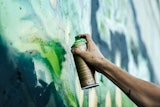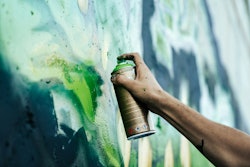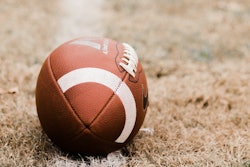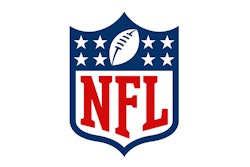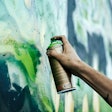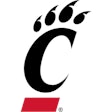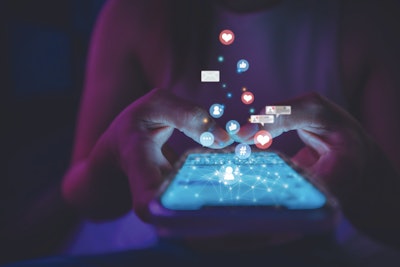
It’s gameday, and your star player is more worried about filming the perfect pregame TikTok than focusing on their upcoming performance. Ten years ago, that scenario would have been unthinkable. Today, it’s becoming an increasingly common concern for coaches and athletic administrators across the country.
There’s good reason for this shift in focus. Our groundbreaking new study shows that the financial opportunities created by name, image and likeness deals are coming with an unexpected price tag: significantly elevated mental health risks for student-athletes who spend too much time creating promotional content.
The study, “Posting Under Pressure” (2021-2025) followed more than 8,000 female basketball players, and we’ve identified some troubling insights around NIL-related content production. Athletes who spend three or more hours each week creating NIL content show 1.5 times higher odds of persistent sadness and hopelessness compared to those who post less frequently. The risk spikes even higher during competitive seasons, when every minute spent on content creation competes with recovery time, academics, game preparation, family time and social life.
These concerning findings align with broader national trends. The NCAA’s 2023 wellbeing survey reported that 35% of female athletes feel “mentally exhausted” most days, while the CDC found 53% of high school girls experience persistent sadness or hopelessness. The generation powering a commercial boom in women’s basketball is also reporting unprecedented levels of psychological distress.
We’ve observed that the trend has become predictable. As teams head into their competitive seasons, athletes face mounting pressure not only from games and academics but from content creation deadlines, brand partnerships and social media management. The planning and support systems that athletic departments need have become much more complex than they were just a few years ago.
Here’s a look at some measures athletic departments can take to ensure they’re prepared to protect student-athlete mental health while preserving NIL opportunities.
Setting manageable production thresholds
Our research data suggests a clear guideline for athletic departments: keep NIL production under three hours per week during competition windows. Below that threshold, mental health indicators tend to resemble baseline levels for student-athletes. Above it, mental health risks can rise sharply.
However, implementing time limits requires careful consideration. Athletic departments need to determine what activities count as content creation, who will monitor compliance and how to balance individual opportunities with team welfare. The goal should be creating actual protection for athletes, not just the appearance of oversight.
Some considerations for effective threshold management include deciding ahead of competitive seasons if exceptions will be made for major championship content or career-defining opportunities. Staff should receive training on recognizing signs of content creation burnout and understanding the mental health resources available. Each program should also assess its acceptable level of risk based on its unique competitive demands and athlete support infrastructure.
Mental health resource planning
Perhaps the most critical step athletic departments can take is developing formal mental health support systems specifically designed for NIL-related stress. This involves coordination between administrators, coaches, counselors and sports psychologists to ensure comprehensive care when athletes struggle with content creation demands.
Currently, only 42% of women’s basketball programs employ a full-time sport psychologist, and few offer NIL-specific counseling. Our research suggests several evidence-based strategies that programs can implement immediately.
Athletic departments should dedicate a percentage of collective NIL revenue to licensed counseling services and social media harassment monitoring. These services, while recommended by the NCAA, currently receive no institutional funding support. Programs should also schedule regular digital “off days” similar to physical rest days, mapping content deadlines against travel schedules and academic requirements to prevent overwhelming athletes during high-stress periods.
Team communication becomes crucial for addressing earning disparities that can create locker room tension. Research from the National Athletic Trainers’ Association shows that coaches who openly discuss NIL deal variations reduce rumor-mill anxiety. Additionally, media literacy education can teach athletes production techniques that significantly reduce shoot-to-post time without sacrificing content authenticity.
Early intervention
The NIL landscape has extended beyond college athletics, with high school athletes increasingly pursuing monetization. Currently, 41 states permit high school NIL deals, but only eight mandate mental health education for teen athletes who monetize their personal brands.
We’ve found that challenges at the high school level are particularly acute. Our preliminary data shows that high school athletes average 75 minutes of production time per sponsored post — significantly longer than college players who have access to campus media teams and professional support. These adolescent athletes often lack the emotional and organizational resources to manage adult-level business responsibilities while maintaining academic and athletic performance.
The case of Jada Williams illustrates both the opportunities and risks. At 17, Williams relocated from Missouri to California largely because state rules there allowed high school NIL deals. By graduation, she had inked national campaigns with Spalding and Gymshark. For Williams, entrepreneurship came with benefits — helping her single mom pay rent — but also with “grownup” deliverables that rarely fit between chemistry lab homework and practice.
Addressing the professional pipeline problem
The economics of women’s professional basketball have created an unusual situation that extends mental health risks beyond the college years. WNBA No. 1 draft picks earn approximately $79,000 annually — substantially less than top college NIL earners, who can generate seven-figure incomes.
This economic inversion incentivizes athletes to delay professional careers and remain in the high-pressure college environment longer. Notre Dame’s Olivia Miles has chosen to pursue her additional years of college eligibility over WNBA draft opportunities, citing superior earning potential and brand development advantages in college.
This financial reality means athletes continue managing the mental demands of college-level content creation rather than transitioning to professional environments with different pressure structures. While the WNBA projects revenues approaching $1 billion for 2025 — suggesting potential salary increases — the current system creates extended exposure to collegiate NIL stress.
Managing high-profile athlete demands
Elite performers face particularly intense content creation pressures. LSU’s Flau’jae Johnson exemplifies both the opportunities and hidden costs of NIL success. Her 15-second TikTok transitions require an hour of preparation, additional editing time and brand approval processes that can extend for days. Despite earning an estimated $1 million in NIL endorsements last season, significantly more than the $78,831 WNBA rookie salary, the constant pressure of content creation demands careful management.
Athletic departments supporting high-profile athletes need specialized strategies. This includes coordinating with brand partners to cluster content creation during designated periods rather than spreading demands throughout the competitive season. Programs should also establish clear communication channels with athletes about their mental health status and provide immediate access to counseling when content pressures become overwhelming.
Building sustainable support systems
Our research indicates that athletic departments can successfully balance NIL opportunities with student-athlete welfare through strategic planning and resource allocation. The key is recognizing that mental health protection represents a competitive advantage rather than just a welfare concern.
Successful programs anticipate mental health challenges during high-stress periods that include championship pursuits and appearances, major endorsement launches or viral social media moments. Athletic directors and coaches who know their athletes well can often identify warning signs before they become crises. They can recognize when content creation is interfering with performance or when social media pressure is affecting an athlete’s mental state.
Programs should monitor athletes’ content creation schedules during competitive seasons and coordinate with academic support staff to ensure NIL activities don’t interfere with educational goals. Regular team meetings should address NIL earning disparities and their potential impact on team chemistry, while sports psychologists should be available to provide specialized support for content creation-related stress.
Our research suggests that with proper planning and support systems, athletic departments can help ensure that NIL opportunities enhance rather than undermine student-athlete development. The programs that prioritize both financial opportunity and psychological wellbeing will likely find themselves best positioned to attract top talent while developing successful, healthy student-athletes.
As women’s basketball stands at a pivotal moment, with unprecedented visibility and cultural influence, the sport’s momentum could stall if athletes burn out before reaching their potential. Mental health isn’t a side issue in the NIL era, it’s the foundation that determines whether these new opportunities become launching pads or unsustainable burdens.













